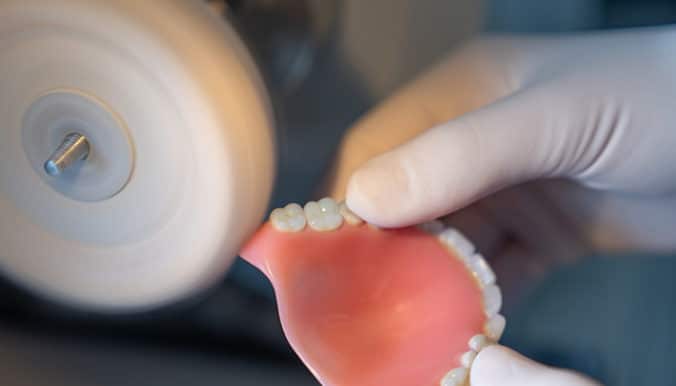Bottom Dentures Problems and How to Fix Them

One of the most common issues from denture wearers is irritation with their full or partial lower denture. From a loose fit and poor suction, to problems with eating or pain from an infection, striving for a better fit can be an ongoing issue.
As denture experts, the team at Emergency Denture Repair are well versed in the typical causes and problems of those with a new full bottom denture. When compared to firmly held upper dentures, loose lower dentures can be incredibly frustrating. We’re here to help, so read on to learn about bottom denture problems and how to fix them.
What is a Full Bottom Denture?
Dentures are realistic custom replicas of teeth and gums, used to replace those lost to age or health issues. A full bottom denture is a complete set of artificial teeth for your lower jaw.
Those with uncomfortable bottom dentures – loose or poor suction are the common issues – should seek professional advice on how to improve their functionality, or whether new quality dentures are required. As we age, our facial structures and jawline change but dentures remain the same, requiring expert assistance to determine the key causes and fixes required.
What Are The Causes of Loose Bottom Dentures?
One of the main reasons patients suffer from bottom denture issues is the lower jaw struggles with space for up and down movement. This worsens as our bones and gums shrink and alter with age, resulting in having bottom dentures loose or ill-fitting with growing discomfort.
This altering of jaw bone shape affects denture retention, as does low amounts of saliva. Those with certain medical conditions or prescriptions can suffer side effects of a lack of saliva, resulting in poor suction of bottom dentures.
A lack of moisture can also warp the denture itself, if left to dry when removed from the mouth. The base of the denture – the section touching the gums – tends to deform over time with a lack of moisture, in turn impacting the jaw shape of the user.
What Are The Typical Issues Related to Loose Bottom Dentures?
There are multiple problems associated with ill-fitting bottom dentures that are loose and poorly suctioned in the mouth:
- Speech impairment due to loose dentures
- Eating is uncomfortable due to a lack of denture suction
- Bottom dentures hurt – painful pinching or irritation when in use
- Opening the mouth widely, or laughing, results in denture looseness
How to Fix Lower Partial Dentures
The first thing to do when dealing with any full or lower partial denture issues is to seek professional help from Emergency Denture Repair. All dentures are a unique shape and fit, meaning each patient requires a custom fix.
New Denture
A new denture design is often the best option to cater to your altered jaw alignment. While new dentures should last around 8 years, unforeseen changes may require a more immediate update.
A Hard Reline
Another option is to have the base of your denture relined, and in some cases it’s enough to reconfigure existing dentures to fit comfortably and function well.
Denture Alternatives
If you have tried multiple fixes for your loose dentures, consider dental implants as a long term solution. This offers a fully supported base for dentures, minimising movement and improving overall functionality.
Leave It To The Experts at EDR
If your bottom dentures hurt or refuse to stay in place, book a consultation with the denture professionals at Emergency Denture Repair. As well as providing immediate care for urgent denture issues, our expert team can advise on the best fixes or new fit for your uncomfortable or loose bottom dentures.
To book a consultation at one of our many Perth clinics, or to ask any queries relating to your full or partial dentures, don’t hesitate to get in touch with our friendly and informative team today.